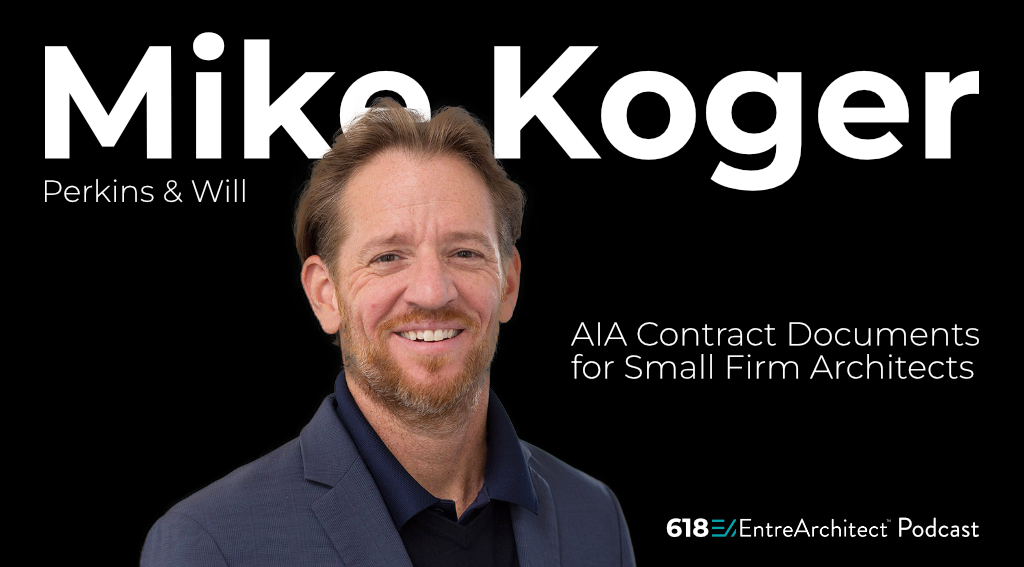
If you’ve ever agreed to work without a contract, failed to charge for additional services, or let a client slide on payment, you’re not alone. These are just a few of the most common architect contract mistakes made by small firm owners—and according to construction attorneys, they happen far too often.
This week on the EntreArchitect Podcast, I sat down with Michael Koger, Associate General Counsel at Perkins and Will and former architect, to talk about the legal traps architects fall into, how to avoid them, and why protecting yourself is the key to growing a strong, resilient practice. Listen to the full conversation at entrearchitect.com/618.
From Architecture to Law: A Unique Perspective
Mike started out like many of us, graduating from Ball State’s architecture program and working at small firms in California. It was there, early in his career, that he first encountered the legal red tape of permitting, zoning, and land use.
“I realized I enjoyed the process of working through codes and laws more than designing buildings,” he said. “It just came more naturally to me.”
That realization led him to law school at Tulane during the Great Recession. From there, he entered construction litigation before spending over a decade at AIA Contract Documents. Today, he brings all of that experience to his role advising one of the world’s largest architecture firms.
The #1 Mistake: Being Too Nice
When preparing for a recent AIA Conference presentation, Mike and a colleague surveyed 30 construction attorneys who regularly represent architects. They asked: what’s the most common weakness you see?
The answer was nearly unanimous.
“Architects are too nice,” he said. “They wait too long to collect payment. They start work without signed agreements. They give away additional services without charging. They bend over backwards to be helpful—and end up hurting their businesses.”
And it’s not just bad for the bottom line. In too many cases, these kinds of decisions expose small firms to lawsuits, financial loss, and broken trust with clients.
How to Set Clear Expectations
So how do you avoid these common architect contract mistakes?
According to Mike, it starts with setting expectations. And that means understanding your own contracts—and using them as a tool, not just a formality.
“Too often, architects file the contract away and only pull it out when something goes wrong,” he said. “But it’s meant to be a guide. Sit down with your client, walk through what’s included in your basic services, and clearly define what counts as additional.”
Article 4 of the AIA B101 agreement is a great place to start. It outlines optional services like historic preservation, LEED consulting, or advanced cost estimating—services that many owners mistakenly assume are part of the standard scope.
By reviewing these line-by-line with your client up front, you establish clarity. Then, when scope creep happens later (and it will), the conversation is easy. You’re not surprising them. You’re simply referring back to the agreement.
Why AIA Contracts Are Built for You
Another myth Mike was quick to bust: AIA contracts are not just for big firms.
“The majority of people using AIA contracts are small firms,” he said. “Firms like Perkins and Will have in-house legal teams. They don’t rely on AIA documents the way small practices do.”
In fact, AIA offers a wide range of contract types—including short-form agreements like B105 for smaller projects, as well as residential-specific forms and guides for condos or pro bono work.
That said, even if you’re using an abbreviated agreement, Mike recommends reviewing the full B101 for reference. “Know what protections you’re giving up,” he said. “Just because a contract is short doesn’t mean it’s fair. Some of the most one-sided agreements I’ve ever seen were less than two pages long.”
Mistake #2: Not Including a Limitation of Liability
Here’s another big one: failing to include a limitation of liability clause.
While this isn’t standard in most AIA agreements, it can be added using the B503 supplemental conditions document. It’s a powerful way to cap your exposure to lawsuits—especially when your design fee is small compared to the value (and risk) of the overall project.
“I’ve seen these clauses get architects out of expensive litigation early,” Mike said. “It’s a fair way to align risk with reward. You shouldn’t be liable for millions of dollars on a $40,000 fee.”
He also recommended including a waiver of consequential damages, which prevents clients from holding you responsible for things like lost rental income or project delays that aren’t your fault.
“These are standard risk management tools,” he added. “And they’re not controversial. They’ve been part of AIA contracts for decades.”
Don’t Rely on AI Without Oversight
With AI rapidly entering the architecture space, it’s tempting to offload research and code review to digital assistants. But that’s another mistake with serious consequences.
Mike reminded us that only licensed professionals—not machines—can practice architecture. And if you rely on AI to interpret zoning codes or building regulations, you’re still the one held responsible if it’s wrong.
I shared a personal story of asking a chatbot about Airbnb zoning in my son’s neighborhood. It confidently provided detailed answers—and cited zoning sections that didn’t exist. In fact, it pulled data from unratified meeting minutes and presented it as law.
It was a good reminder that tools are only as good as the oversight we apply.
“If you’re going to use AI tools, validate the information,” Mike said. “And when in doubt, use vetted platforms built for architects—not general-purpose chatbots.”
The Final Word: Take Risks, But Be Smart
I always close our interviews with this question: What’s one thing small firm architects can do today to build a better business tomorrow?
Mike’s answer was honest and empowering.
“You have to take risks to grow. That’s business. But take calculated risks,” he said. “Get the right contracts in place. Set expectations. Limit your liability. Then go build the business you dream about.”
There’s nothing wrong with being nice. But in this profession, being too nice—without protection—is one of the most dangerous architect contract mistakes you can make.
Let’s stop repeating them. Let’s build smarter.
Listen to the full conversation with Michael Koger at entrearchitect.com/618. You’ll walk away wiser, stronger, and more confident in your contracts. And your business will be better for it.

Worth quoting:
That said, even if you’re using an abbreviated agreement, Mike recommends reviewing the full B101 for reference. “Know what protections you’re giving up,” he said. “Just because a contract is short doesn’t mean it’s fair. Some of the most one-sided agreements I’ve ever seen were less than two pages long.”